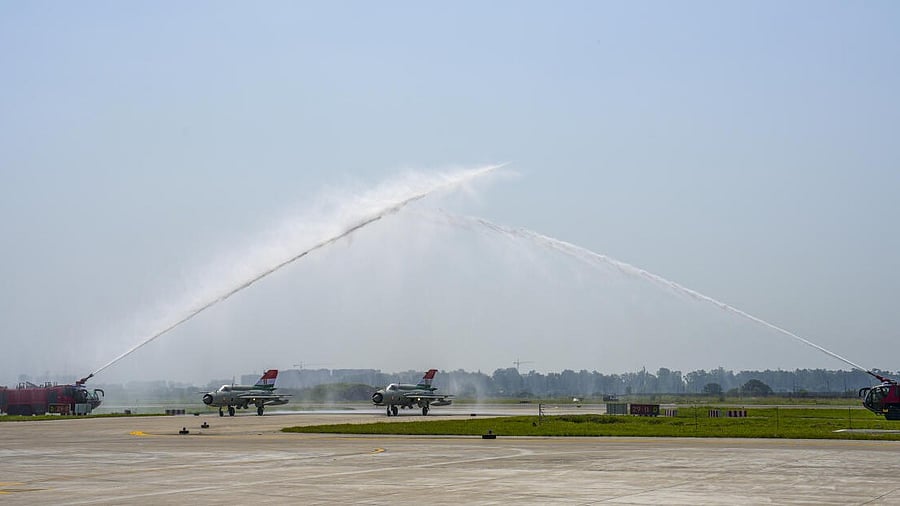
Indian Air Force MiG-21 aircraft receive water salute during the ‘MiG-21 Operational Flying Culmination Ceremony’
Credit: PTI Photo
With the retirement of the MiG-21 formalised in Chandigarh on Friday, a longish chapter in the history of the Indian Air Force (IAF) has been concluded. The withdrawal of the last of the MiG-21s also highlights the stark shortage of combat aircraft in the IAF. In the hazy past, the collective wisdom of a Parliamentary Committee had arrived at the figure of 42 squadrons as the need of the IAF. However, this figure was never reached. The highest ever was 41, for a short period in the 1990s. The current squadron tally stands at 29.
Operation Sindoor saw the IAF lead the short and swift conflict, inflicting severe damage to Pakistan’s air assets as well as air defence installations. This suggests that future engagements with Pakistan may again invoke the IAF to be the lead player so that a strategic restraint is maintained while engaging Pakistani targets effectively in the air and on the ground. The IAF and the analysts agree that a squadron of 29 is inadequate for the IAF’s current roles and tasks, which include the responsibility of air defence of Indian territory and its territorial waters.
Operation Sindoor also highlighted the threat of collusion between China and Pakistan; the possibility of a two-front war is even more daunting, and the shortage of combat aircraft, that much more distressing. Yet another challenge is the government’s march towards theatrisation, a dispensation that will disperse IAF’s assets under theatres with defined geographical areas of responsibility. The IAF understands the implications of deploying combat aircraft under diverse commands and at dispersed bases. Again, the focus shifts back to the dire shortfall of combat aircraft.
The current need of the IAF is far more than even the sanctioned strength of 42. Considering all the above reasons, there is a cogitation underway to consider IAF’s long-standing demands for raising the sanctioned strength. But where are they going to come from?
Let us start with indigenous endeavours. The MiG-21 was inducted in 1963, and by the 1980s, the IAF projected a need to replace it. Hindustan Aeronautics Limited (HAL) launched the Tejas programme in 1983, aimed at developing a 4th-generation fighter by the 1990s. The Tejas Mk1A is projected to have 40-odd improvements over the Mk1, including in sophisticated radars and weaponry. The first Tejas Mk1A is yet to be delivered to the IAF. Until March this year, the delay was attributed to General Electric, the US engine supplier, not being able to deliver the engines on time. Since then, the first three engines have reached HAL (one each in March, July, and September). The defence PSU has announced plans for 12 Tejas Mk1A during this financial year, but the history of timelines tells us to temper expectations.
Another wake-up call
Tejas Mk2 is a different kettle of fish altogether. It is reasonable to presume that the delays with the advanced aircraft would be at least as frustrating for the IAF as it was for Tejas Mk1/1A. The next indigenous venture in the making is the Advanced Medium Combat Aircraft (AMCA), a complex programme with no projected date of induction in the visible time horizon.
So where does that leave us? Regrettably, with no other choice except for fighters from a foreign manufacturer. Indeed, this was more or less apparent in 2007, and a procurement programme called Medium Multi Role Combat Aircraft (MMRCA) was launched. After a painstaking selection process from amongst seven contenders, the French Dassault Rafale was selected in 2012, but in 2015, the government scrapped the deal. Instead, the next year, 36 Rafales were purchased in a government-to-government deal with France.
The inanity of the MMRCA termination was evident from the fact that in 2018, a new procurement programme called Multi Role Fighter Aircraft (MRFA) was initiated. There are currently eight contenders, including Rafale F-4, an advanced version. However, the MRFA programme also seems to be moving at a snail’s pace that is not commensurate with the IAF’s needs for advanced fighters.
A pigeon cooing outside your window can keep you awake, but the sound of a window air conditioner – humming at a much higher decibel level – permits you to sleep because it is continual, and the mind learns to accept it as background noise. The nation has, for long, ignored the IAF’s continual calls for combat aircraft, and it is used to them as background noise. Now is the time to wake up to them.
(The writer is an IAF veteran)